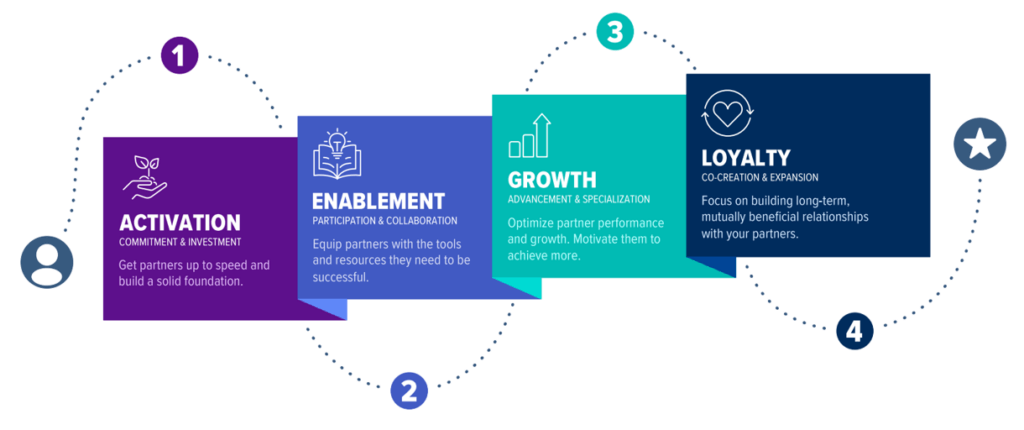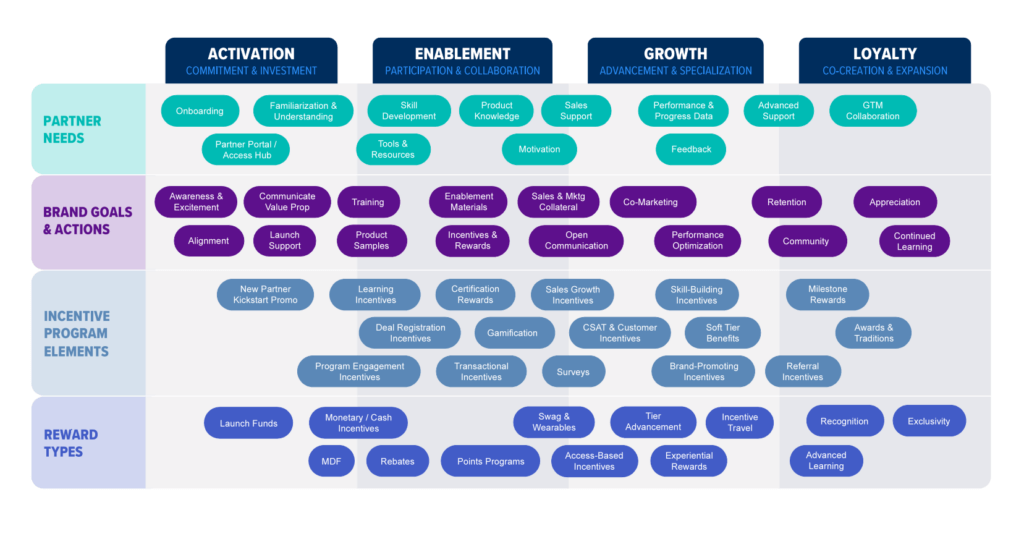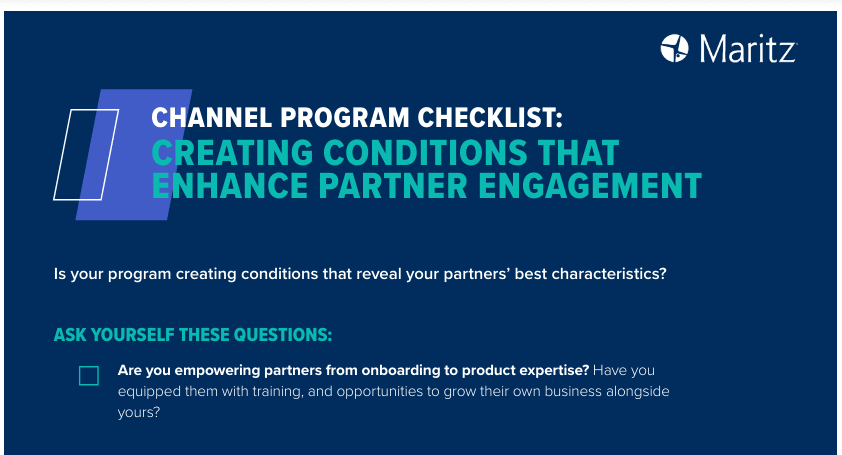
Imagine building a dream team. An empowered group of confident, strong performers who move frictionlessly toward collective goals. Each player will need a unique training plan to reach their full potential. The same goes for business partnerships.
New partners entering your program have distinct needs compared to your established MVPs. So, what’s the secret to keeping both experienced players and rookies actively engaged and thriving in your program? Understanding the Partner Journey.
This journey isn’t a one-size-fits-all trip. It’s a roadmap with distinct phases, each catering to specific partner goals and challenges. So, now you have recruited and signed on a new partner. How do you keep engagement up at each phase – from Activation to Enablement to Growth to Loyalty? By understanding these four phases, you can tailor your approach to each partner, building a strong foundation for their success and, ultimately, yours.

What Does the Partner Journey Map Cover?
Before we get into the specifics of each phase, let’s break down the partner journey into actionable categories.
Our “cheat sheet” will help you navigate the unique needs of your partners at each stage, identify milestones and consider what ideas to activate and which levers to pull. For each of the four phases, these categories will outline the specific actions you can take to support that part of the partner journey:
- Partner Needs: What motivates and supports partners at this stage?
- Brand Goals & Actions: What are your objectives for partner engagement in this phase?
- Incentive Program Elements: What program features or design elements are most effective at this stage?
- Reward Types: What types of rewards best resonate with partners at this point in their journey?
By understanding these interconnected elements, you can design winning incentive programs that effectively motivate and nurture your channel partners throughout their entire experience, fueling success and fostering mutually beneficial relationships.
REMEMBER: Every program is unique, so consider these as springboards to craft your personalized approach. Here’s an example of one program’s fully loaded partner journey map.

For mature programs like this one, a lot of elements are at play compared to newer programs that will scale as they go. Keep in mind that while partner organizations may be in a more advanced phase, individual new hires or fresh salespeople within that organization could be at different individual stages and require tailored support and incentives.
Your map can be similar or unique to your strategies, but many of these actions should be ongoing and often. Some initiatives might even overlap between phases or could be used to propel a partner to the next stage of the journey.
For instance – enablement never stops. It should be a consistent effort of your partner program to make sure participants are educated, trained and supported with the materials they need to sell your current and new products. While enablement is pivotal for each leg of the partner journey, this map designated it as a distinct phase to give it the attention and focus it rightfully deserves.
Now that you’ve got an overview, let’s go deeper into the minds of your channel partners. What do they really want from your program during each phase of their journey? What do they need?
Phase One: Activation
(Investment & Foundation)
Your partners are newly signed and eager to get started. Before they can jump in full force, they need a solid foundation. This phase is responsible for getting partners up to speed and aligned with your program’s value proposition.
Key activities within the activation phase include onboarding and ensuring partners understand your program benefits and how to participate.
Partner Needs
What Motivates and Supports Partners at This Stage?
- Onboarding (clear instructions and expectations, early access)
- Familiarization and Understanding (brand, program, role)
- Tool Access (partner portal or access hub)
Brand Goals & Actions
What are your objectives for partner engagement in this phase?
- Build awareness and excitement
- Communicate value propositions
- Create brand and program alignment
- Enroll new participants in the partner portal or access hub
Incentive Program Elements
What program features or design elements are most effective at this stage?
- New Partner Kickstart Promos
- Program Engagement Incentives
Reward Types
What types of rewards best resonate with partners at this point in their journey??
- Launch Funds
- Monetary or Cash Incentives
- MDF Opportunities
Phase Two: Enablement
(Participation & Collaboration)
Partners are starting to get into the groove of your program. To keep momentum, they need to be equipped with additional tools and resources to hone their skills and be successful.
Key activities during the enablement phase include providing training materials, product knowledge reinforcement and sales support. Collaboration through co-marketing efforts may also be initiated at this stage.
Partner Needs
What Motivates and Supports Partners at This Stage?
- Sales Tools (marketing collateral)
- Skill Development and Training (coaching, sales strategy, soft skills)
- Training (coaching, sales strategy, soft skills)
- Product Knowledge (training and certifications)
- Motivation (recognition and acknowledgement)
- Sales Support (seller playbooks, closure assistance, tech aid)
Brand Goals & Actions
What are your objectives for partner engagement in this phase?
- Optimize the partner portal and access hub
Encourage product or skills training - Offer enablement materials (training guides, brand playbooks, product sheets, etc.)
- Provide sales and marketing collateral (sales scripts, marketing brochures, pitch decks, etc.)
- Leverage incentives and rewards
Incentive Program Elements
What program features or design elements are most effective at this stage?
- Program Engagement Incentives
- Learning Incentives
- Deal Registration Incentives
- Transactional Incentives
- Certification Rewards
- Gamification (leaderboards, progress trackers)
- Program Surveys
- Sales Growth Incentives
Reward Types
What types of rewards best resonate with partners at this point in their journey?
- Monetary or Cash Incentives
- MDF
- Rebates
- Points Programs
- Swag and Wearables
- Access-Based Incentives
Phase Three: Growth
(Advancement & Specialization)
Partner Needs
What motivates and supports partners at this stage?
Partnerships are maturing, and with the foundation laid, it’s time to focus on optimizing performance and growth.
Key activities during the growth phase include providing incentives for achieving sales targets and offering advanced support tailored to the partner’s needs. Open communication is also key to understanding partner needs and tailoring program elements for maximum impact.
- Sales Support (collateral, seller playbooks, deal closure assistance
- Motivation (encouragement and recognition)
- Performance Data
- Feedback
- Advanced Support (field team reps, customer service, tech support, expedited shipping, etc.)
Brand Goals & Actions
What are your objectives for partner engagement in this phase?
- Optimize incentives and rewards
- Support co-marketing efforts
- Maintain open communication
- Retention
- Community-building
Incentive Program Elements
What program features or design elements are most effective at this stage?
- Sales Growth Incentives
- CSAT & Customer Incentives
- Surveys
- Skill-Building Incentives
- Soft Tier Benefits (non-marketing perks, access-based rewards, etc.)
- Brand-Promoting Incentives (co-marketing, use of MDF funds, etc.)
- Referral Incentives
Reward Types
What types of rewards best resonate with partners at this point in their journey?
- Tier Advancement
- Access-Based Incentives (certifications, tier benefits, etc.)
- Swag & Wearables
- Experiential Rewards
- Incentive Travel
Phase Four: Loyalty
(Co-Creation & Expansion)
The partnership has taken shape and there’s room to evolve the connection. Next on the agenda is prioritizing opportunities to build a long-term mutually beneficial relationship with your partners.
Key activities during the loyalty phase include recognizing partner achievements, incorporating partner feedback into program development and fostering a sense of community. Co-creation efforts may occur at this stage, where you collaborate with partners on new product development or marketing initiatives.
Partner Needs
What motivates and supports partners at this stage?
- Advanced Support (field team reps, tech support, customer service, expedited shipping, etc.)
- GTM Collaboration
Brand Goals & Actions
What are your objectives for partner engagement in this phase?
- Retention
- Community-Building
- Showing Appreciation (recognition, awards and rewards)
- Providing Continued Learning (product expertise, soft skills, etc.)
Incentive Program Elements
What program features or design elements are most effective at this stage?
- Milestone Rewards
- Referral Incentives
- Awards & Traditions
Reward Types
What motivates and supports partners at this stage?
- Recognition
- Exclusivity (access to limited or early-release products)
- Advanced Learning (tier-based learning courses)
Your Dream Team Awaits
The Partner Journey isn’t a rigid path. It’s a map that leads to thriving partnerships. Think of it as a growth plan that can be personalized and tailored to each partner’s unique needs and goals. When you support their process, you enhance their entire program experience.
By implementing the actionable steps we’ve explored, you can strike the right combination to keep your partners engaged, motivated and successful at every stage. Start strategizing, coach, and see how your dream team can soar.
Want help building your own unique partner journey map? Contact us to learn more.


